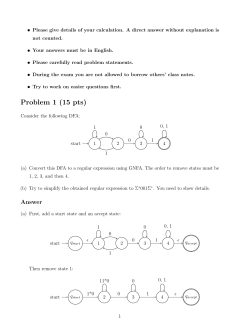
A short note on finding the limit of a sequence...
The 31st Workshop on Combinatorial Mathematics and Computation Theory
A short note on finding the limit of a sequence computed by a DFA *
Ren-He Hsiao, Mu-Jung Tsai and Ching-Lueh Chang
Department of Computer Science and Engineering (all authors)
Innovation Center for Big Data and Digital Convergence (Ching-Lueh Chang)
Yuan Ze University, Taoyuan, Taiwan
{s1001527, s1003348}@mail.yzu.edu.tw, clchang@saturn.yzu.edu.tw
𝑙𝑖𝑚 𝑀 1𝑛
exists and can be found in time linear in the
number of states of 𝑀 , where 𝑀 1𝑛 is
interpreted as a sequence of digits after the radix
point and thus 𝑀 1𝑛 ∈ 0,1 for each 𝑛 ∈ ℤ+ .
Proof. Write m for the number of states of M.
By the pigeonhole principle, there exist positive
integers h, k ≤ m + 1 such that 1h and 1h+k
lead M to the same state, say q. Denote by s the
output of M on 1k , assuming that M starts from
the state q. Now, for t ∈ ℤ+ , M 1h+kt equals
M 1h
concatenated with t copies of s .
Therefore,
lim M 1h+kt = 0. M 1h ss …,
t→∞
where the strings in the right-hand side above are
concatenated by juxtaposition. This implies
lim M 1n = 0. M 1h ss …,
n→∞
because M 1q
is a substring of M 1r
whenever q ≤ r.
To find positive integers h, k ≤ m + 1 such
that 1h and 1h+k lead M to the same state, it
suffices to simulate M on 1m+1 until a state is
repeated. Once h and k are determined, it is
easy to find s in O m time.
Abstract
𝑛→∞
We prove a folklore result regarding the limit of
any sequence computed by a deterministic finite
automaton. We do not know of the result, albeit
folklore, being proven elsewhere.
1
Introduction
The Bolzano–Weierstrass theorem states that
every bounded sequence in a finite-dimensional
Euclidean space has a converging subsequence [1].
In particular, every bounded sequence of real
numbers has an accumulation point. We are
interested in finding an accumulation point (or the
limit if it exists) of a sequence computed by a
machine. It is folklore that given a deterministic
finite automaton (DFA) M with outputs,
limn→∞ M 1n an accumulation point of the
exists and can be found in linear time, where
M 1n is interpreted as a sequence of digits
after the radix point and thus M 1n ∈ 0,1 for
each n ∈ ℤ+ . This short note presents a complete
proof, which we do not find elsewhere, of this
folklore result.
A DFA with outputs is a finite state machine
with an initial state and several directed arrows
between states. Each directed arrow is labeled
with a character. When a DFA gets an input, it will
read one character at a time and follow the arrow
labeled with that character until the input is
exhausted. We can also assign some output to each
arrow of a DFA. So, when going through an arrow,
the DFA outputs.
2
Finding limits
computed by DFAs
of
We propose the following question: Is it true
that given a deterministic pushdown automaton M
with outputs and ϵ > 0, an accumulation point of
M 1n ∞
n=0 can be approximated to within an
additive error of ϵ?
3
Conclusions
We provide a proof for the folklore result that,
given a DFA M with outputs,
lim M 1n
n→∞
exists and can be found in time linear in the
number of states of M . We are interested in
whether a similar result holds when M is a
deterministic pushdown automaton instead.
sequences
This short note proves the following folklore
theorem, for which we do not know of a written
proof elsewhere.
Acknowledgments
Theorem 1. Given a deterministic finite
automaton (DFA) 𝑀 with at most one output
character assigned to each arrow,
Ching-Lueh Chang is supported in part by the
National
Science
Council
under
grant
226
The 31st Workshop on Combinatorial Mathematics and Computation Theory
NSC101-2221-E-155-015-MY2 and the Ministry
of Economic Affairs under grant 102-E0616.
References
[1] W. Rudin. Principles of Mathematical
Analysis. McGraw--Hill, 3rd edition, 1976.
227
© Copyright 2025





















